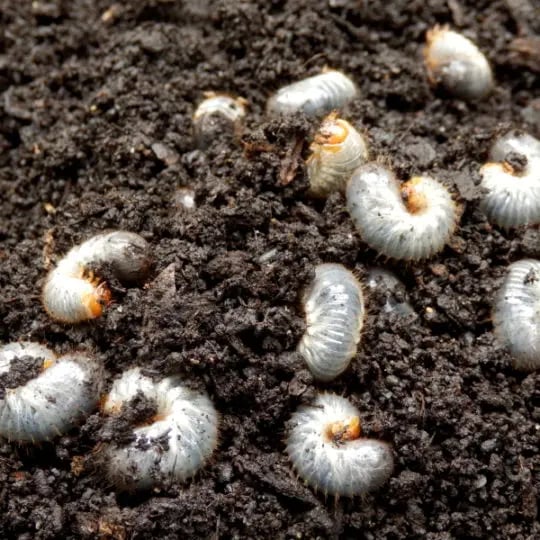How to Get Rid of Grubs in Lawn

Lawn grubs are common garden pests that live in your soil, eat grass roots, and eventually turn your yard brown. They often attract other unwelcome animals that come to feed on them as they dig up grass patches in the process. The key to combating lawn grubs is in prevention and early detection. Read on to learn more about grubs and grub control in order to avoid the massive lawn damage they inflict.
Identifying Grubs
Grubs are the larvae of beetles (most commonly Japanese beetles). They hatch from their eggs 2 to 4 weeks after being laid in July and begin to feed almost immediately. Grub damage usually starts to show in August and September, depending on the beetle type. Full-grown grubs are approximately 2” in length and are white in color, developing a darker tail end as they mature.
Lifespan
Grub worms typically live for about one year. Every winter they venture into the soil to hibernate, returning to the root layer by spring in time to develop into beetles. Grubs begin feeding on your grass in the spring, but the damage will be most visible in the summer when your lawn may be encountering other stresses, like heat, sun, and drought conditions.
Damage
Grubs are attracted to healthy, thick grass. Healthy grass means a healthy root system, which is what the grubs feed on as soon as they hatch. The higher the concentration of larvae, the more severe your lawn damage will be. Grub damage shows in the form of brown, wilting grass in irregularly shaped patches throughout your yard. Because grubs eat away at your lawn’s root system, its turf becomes loose and can be peeled back as if it were new sod. Grub worms reside beneath this turf layer and should be visible as you peel back the turf.
Prevention
Even if your lawn is not normally infested by grubs, a little lawn maintenance can go a long way in preventing an outbreak that could potentially damage your lawn beyond repair. You can prevent grubs from hatching and maturing by applying a lawn insect control treatment early in the growing season. The best, most-effective route to take, however, is to schedule routine treatments with a professional lawn service.
Damage Control
Once you have discovered a grub worm infestation, it may be too late to save your turf. Because the pesky worms go right for your root system, it is difficult to reverse grub damage. Once the signs of grubs become apparent, your best bet is to treat your lawn with a granular insecticide. This should be applied to the damaged patches and surrounding areas to stop the grubs from spreading out to attack more healthy grass roots. Damaged roots will most likely not rebound from the grub attacks, so the affected areas will require reseeding in the early spring or fall, which leaves unsightly bare patches throughout the yard.
Because grub destruction is often impossible to repair, it is much more expensive to fix your lawn after the worms have done their damage. The more wallet-friendly way to combat grubs is to perform routine applications to control grub populations in your turf. Committing to a regularly scheduled turf application program can help keep grubs at bay at a more reasonable cost.
Interested in protecting your lawn from grubs? Any further grub-related questions? Call us today for expert solutions and professional advice for keeping your lawn pest-free.